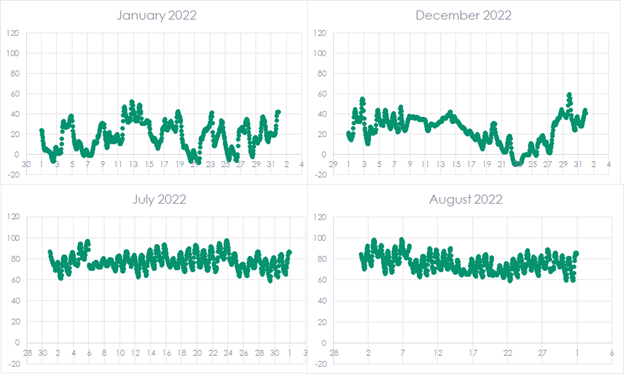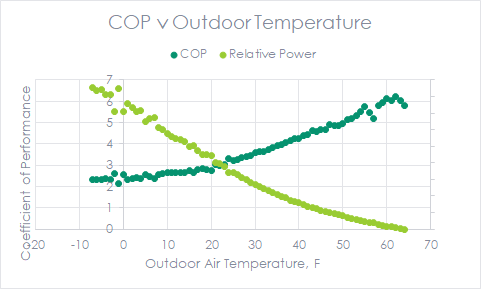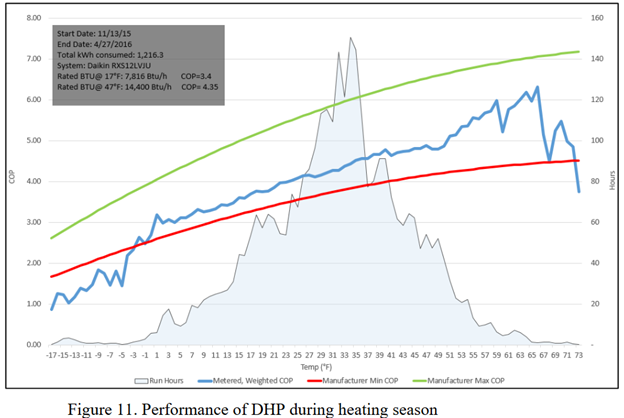
Here are my last words, for now, on artificial intelligence: I do not claim to understand the computations or systems behind AI whatsoever. However, I do understand human behavior very well, so when I saw a headline last week, JPMorgan CEO: AI Will Eventually Lead to 3.5-Day Workweek, my response was, never, not going to happen. I mean, people will not be compensated with 40 hours of pay for 28 hours of work. That is fantasy. I remember dispelling such fiction as a grade schooler because the same concept was floated back in the 1970s. Only the mode of automation has changed.
Thermal Storage: Heating v Cooling
While we are focusing on load management with thermal storage and more conventional demand response to mitigate grid pain during heat waves, this post pulls the alarm for avoidable grid pain delivered by arctic air. Now, or maybe yesterday, is the time for utilities to act to avoid grid stress over the next few decades before heating electrification is promoted without critical thought about peak load contributions. From my observations, the sentiment is to electrify everything, and we’ll burn the reliability bridge once we get there—bad plan.
There are several significant differences to consider when minimizing peak grid loads and stress during peak electrified heating and cooling scenarios. To demonstrate, metered temperature data are plotted below for Des Moines, Iowa, including two peak heating months of January and December and two peak cooling months of July and August.
 Three Challenging Characteristics of Electrified Heating
Three Challenging Characteristics of Electrified Heating
Notice three things. First, the temperature volatility in wintertime is much greater than in summer. Why is this? Greenhouse gases. In the summer, there is always significant water vapor in the air, trapping more heat and stabilizing temperatures. The temperature band in the cooling season is about 40 degrees from low to high. It’s almost double that in the heating season, at about 70 degrees.
Second, every cooling day has a significant recovery opportunity to recharge and catch up with the load. This makes thermal storage much easier to accomplish because every 24-hour cycle provides an opportunity to recharge efficiently. Plunges of arctic air can last two to four days. Designing a reliable thermal storage system for heating is much more unpredictable and expensive.
Third, cold weather extremes have a temperature difference between indoors and outdoors of at least 80 degrees versus a measly 30 degrees in the cooling season. This matters because the efficiency of the golden child of electrified heating, the air source heat pump, drops significantly in cold weather. This effect is demonstrated in the following chart of metered efficiency[1].
 Air Source Heat Pump Performance
Air Source Heat Pump Performance
Air source heat pump efficiency drops about 65% from mild weather heating at around 60 degrees and about 50% from moderate heating conditions at 30 degrees. Combine the increasing heating load and decreasing efficiency, and the relative power (grid load) increases exponentially as temperatures plummet.
We have more data to collect on cold climate heat pumps, particularly in severe cold. Meanwhile, this paper published in 2016 shows heat pumps going to full supplemental – e.g., inefficient, expensive, peaking electric resistance below -10 degrees F.
 Solar and Peak Heating – a Poor Combination
Solar and Peak Heating – a Poor Combination
Utilities in the north planning to build gigawatts of solar and electrifying electric loads need to think critically about loads and supply. Cold climates and decarbonization with electrified heating and solar are a combination for severe pain. Solar pairs well with summer peak loading like Gulf Coast states, Arizona, and the West Coast. Great Lakes states and the northeast. Mmm. No.
Peak Heating Load Mitigation
The first way to mitigate grid stress and upward pressure on prices is flexibility with hybrid heat pumps. Many cold regions of the country have access to natural gas. Use it when necessary, with a hybrid heat pump and call on natural gas during peak periods. The carbon impact is infinitesimal compared to the enormous, avoided infrastructure cost of heating buildings with inefficient toaster coils a few hours a year.
Second, the only viable means to carry a thermal load during a multiple-day arctic blast is the earth. The geothermal heat pump, aka ground source heat pump, craze peaked before the current electrification craze kicked in. This is unfortunate. Geothermal heat pumps were Iowa’s sport utility vehicle for HVAC during the 1990s and aughts. Everybody wanted geothermal. What happened? I think cost-effectiveness tests are primarily to blame, just as they are for failing to accommodate load-shifting distributed energy resources today. Policymakers need to get with the program – the program is a reliable, affordable electricity service.
Lastly, some companies are exploring phase change materials (PCM) to store thermal energy for heating. Like a heat pump, the system reverses and charges the PCM (water) by melting ice. The system discharges by extracting heat from the water until it is frozen. The problem is this strategy is demonstrated in the weather data above. Heating isn’t the same as cooling, where there is an opportunity to charge diurnally. Once the water is frozen, it’s over, unlike the thermal reservoir in the ground. In a hot climate like Florida or Arizona, diurnal thermal storage for heating can work, but who needs it? These places will always be summer peaking. So, I do not see the value as a grid resource.
Concluding Summary
- Limit winter peaks for reliability and lower electricity costs using hybrid gas/electric heat pumps and ground source heat pump systems.
- Utility-scale solar in heating-dominated climates is not a good idea for reliability and affordability.
[1] Coefficient of performance, or COP equals Btus of heat delivered per Btu of electrical energy consumed.

 Air Source Heat Pump Performance
Air Source Heat Pump Performance Solar and Peak Heating – a Poor Combination
Solar and Peak Heating – a Poor Combination